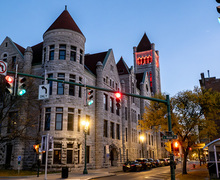ESF : On location: Faculty utilize resources of Adirondacks campus, offer full-semester courses
Nestled in the heart of a 15,000-acre forest preserve in the Adirondacks is SUNY-ESF’s Northern Forest Institute, which is now offering students the opportunity to take full-semester courses for the first time.
Students who sign up for ‘Understanding the Park,’ the residential semester worth 16 credits, will live in cabins at the Huntington Wildlife Forest in Newcomb, N.Y. The goal of the program is for students to learn about ways to promote cooperation between people and the environment through studying numerous topics.
‘We realized we have a pretty great resource up there,’ said Paul Hai, program coordinator for the State University of New York College of Environmental Science and Forestry’s Northern Forest Institute. ‘We’ve been doing educational outreach there for many years, but we’ve never actually done an academic semester before.’
Hai said he will teach two of the classes that will be offered: ‘Adirondack Experience’ and a selected topics course.
He said that with the legacy, research knowledge and connections ESF has to the Newcomb campus, the residential semester can provide students with a really unique and integrated experience of how the Huntington Wildlife Forest functions.
‘When you integrate multiple perspectives, you get a much broader understanding of the history of the problems the park faces as a mixture of both human communities and natural communities,’ Hai said.
Hai said the program is trying to balance the Adirondacks, the largest wilderness reserve on the East Coast, with the economic development of communities. Much of the classwork will be outdoors, he said.
Students will address problems hands-on by forming panels on subjects, such as the debate about logging in the Adirondacks, and by visiting working logging mills and forests where logging is taking place, Hai said.
The Newcomb campus has efficient cabins, dorms and a dining hall.
Students can take a variety of courses on topics such as political science, social science, ethics, environmental philosophy and human dimensions to learn about how the Huntington Wildlife Forest can move ahead on conservation priorities, Hai said.
There will be no prerequisites for the program, which is open to any interested upper-division undergraduate or graduate student from the SUNY system or private universities, Hai said.
Students will also be taking a three-credit independent study course, Hai said, in which they will write a paper outlining their vision for the park and how they believe such a vision could be accomplished.
‘It’s a wonderful place to do this kind of work,’ said Marianne Patinelli-Dubay, who will teach an ethics course at the Newcomb campus. ‘You can really be in residence with the ideas and the topics we will translate in class.’
Patinelli-Dubay also said students in her class will use readings that outline some of the topics about how the land is used, who uses it and how restricted areas are handled.
‘I am really looking forward to bringing students into that ongoing conversation,’ she said.
Katherine Tiedemann, a freshman environmental science major, said she is most eager about the location of the program.
‘I kind of like being out in less urban areas,’ she said. ‘I think it reflects more of the ESF values.’
Jocelyn Gan, a junior environmental science and renewable energy major, said she believes the program can serve as a study abroad experience for ESF students.
‘I know a lot of people want to study abroad and can’t, so they would probably be interested in getting off of the campus,’ she said. ‘The only time you can really do stuff like this is right now when you are in college.’
Patinelli-Dubay said she thinks it would be wonderful if the program became something ESF offered to its students every year.
‘I don’t see why this should just be something we do once,’ she said.
Hai said he hopes students who leave the program will have a much better appreciation for the spectrum of perspectives balancing interactions between the people living in the Adirondacks and the environment.
Said Hai: ‘I also hope it will give students the ability to look at other landscapes where human and natural communities are trying to coexist and see the Adirondacks as a global model for making these interactions work.’
Published on March 4, 2012 at 12:00 pm
Contact Shannon: smhazlit@syr.edu





